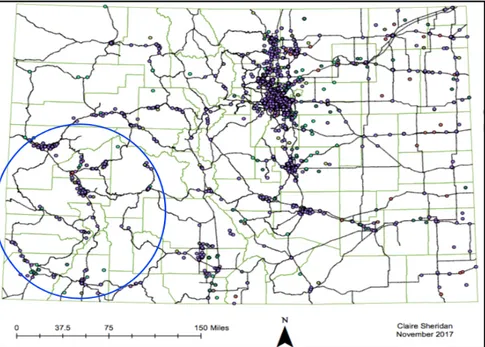Agricultural Manufacturing and Rural Development
Claire Sheridan, Becca Jablonski and Alessandro Bonanno REDI Report – December 2018
http://redi.colostate.edu/
Many rural communities face unique challenges that put them at a competitive disadvantage relative to urban areas. Shrinking population, high unemployment, and stagnant income
contribute to growing pockets of persistent poverty in rural counties.1 Given the growth of U.S.
agricultural exports, as well as consumer interest in agricultural product differentiation through branding and certifications, opportunities may exist for rural businesses to add value to
agricultural products. In support of this opportunity, Congress made funding mandatory and permanent for the U.S. Department of Agriculture Rural Development’s Value Added Producers Grant in the 2018 Farm Bill.2
Despite this policy support, as well as the historical importance of value added agriculture to rural economic development, limited research studies agricultural manufacturers’ location decisions. Though manufacturing location decisions have been well examined, there are intuitive reasons why agricultural manufacturing location decision may vary. For example, agricultural inputs can be costly to transport, and labor needs are different from other manufacturing sectors. This research evaluates what place-based characteristics influence the location decision of agricultural manufacturing firms across the state of Colorado. Understanding the characteristics that are appealing to firms in this sector can help policy makers leverage their comparative advantage to attract more establishments and promote economic development.
Working closely with the Colorado Department of Agriculture and the Colorado Department of Public Health and the Environment, we developed a unique database of agricultural
manufacturing firms across the state (see Figure 1). Analyzing this unique dataset, we compared the location decision of these firms with the place-based characteristics of their locations across Colorado. The characteristics were drawn from traditional economic theory, which argues that factors that reduce costs and increase revenue will influence firms’ location decisions. This model confirmed what previous literature ascertained: taxes, population, industry agglomeration, urbanization and wages were significantly correlated with agricultural manufacturing locations across the state.
1 Cromartie, John. “Rural America at a Glance.” USDA Economic Research Service. Economic Information
Bulletin 182: November 2017.
2 National Sustainable Agriculture Coalition. “2018 Farm Bill by the Numbers.” NSAC’s Blog.
http://sustainableagriculture.net/blog/2018-farm-bill-by-the-numbers/ December 2018.
Ø Factors other than profit maximization motives may influence food manufacturing firms’ decision to locate in rural places.
Ø Quality of life, access to raw agricultural inputs and connection to community are factors most likely to contribute to rural firm location decision.
Ø Value-added manufacturing supports backwards linkages in the supply chain, with potential indirect economic impacts for agricultural firms and rural communities.
We also analyzed firm location decisions using a more diverse and inclusive set of factors, hypothesizing that some firms may choose to locate in regions for noneconomic reasons (for example, quality of life). To collect additional information on firms’ location decisions we surveyed 42 food
processing firms located in a 10-county region in
Southwestern Colorado (see the blue circle in Figure 1).3
The survey revealed that access to inputs, quality of life factors, and connection to community were the most influential reasons for firms to
choose a rural location. Additionally, 33 firms, or 92% of businesses interviewed, reported purchasing local inputs, indicating backwards linkages in the supply chain that may foster local economic development.
Based on the findings from the survey, we re-estimated a state-wide model including measurements of stocks of wealth specific to a location by indexing built, financial,
social/political, cultural, human and natural capitals. Preliminary findings suggest that these capitals have a strong correlation to firm location decision. These variables seem to have a (joint) statistically significant impact on the number of firms in a given area. Additionally, results show substantial differences between rural and urban areas. This suggests that firm location decisions in rural areas are complex, and using a more inclusive framework rather than a profit
maximization one, can help to understand firm location decisions.
Agricultural manufacturing may provide opportunities for rural economic development in some communities. Bottom-up policy approaches, which allow each community to identify their comparative advantage and promote their specific assets, are likely important. Strategies to promote development could include leveraging an economic niche or promoting
entrepreneurialism within agricultural industry clusters.
Acknowledgements: Funding for this project was provided by The Nature Conservancy. The authors also wish to thank the Colorado Department of Agriculture and the Colorado Department of Public Health and the Environment for their assistance.
3 Differences in counties include: range from metropolitan to highly rural; agricultural output very high in
some counties such as Montrose while other counties have none; unemployment rates from 3.5% in La Plata to 10% in Mesa Counties; and so on.
